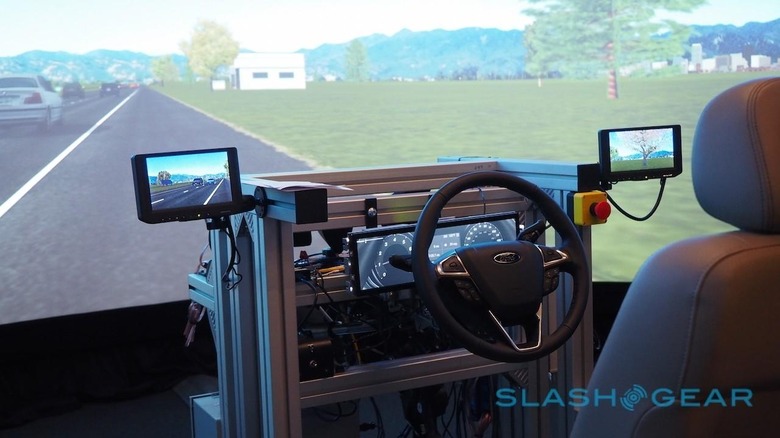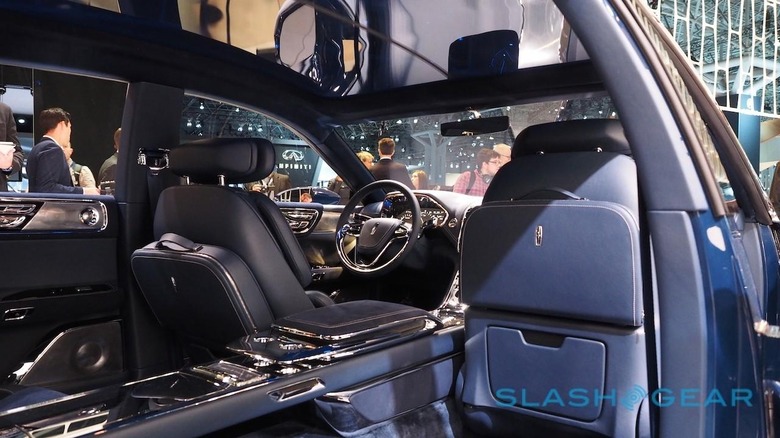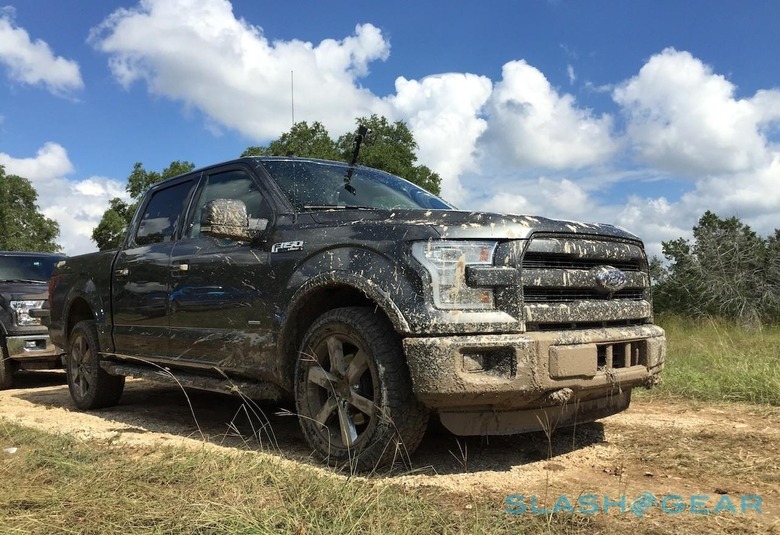Talking Ford GT And Self-Driving Cars With CEO Mark Fields
Ford CEO Mark Fields is on a mission, and while aluminum, rubber, and steel might be the most obvious part of that – whether a truck like the F-150 or a legitimate supercar like the GT – the blue oval boss wants to make sure technology gets its dues. I revisited Ford's Research and Innovation Center in Palo Alto, California to talk about autonomous vehicles and how they can co-exist with super-niche metal like the GT, why the rule book for selling trucks can be the blueprint for the connected car, and just how Ford is going about being good geek neighbors.
With just a few months under its collective belt, and around 40 on the staff, the R&D outpost is already punching above its weight. "The team has delivered twice the rate of invention disclosures for a team this size in the industry," Fields said at the start of the day, already responsible for around 30 new technologies and components across wearables, sensors, and more. It's the team Ford turned to to cook up an Apple Watch version of the MyFord mobile app, turned around in a week, for instance.

However, it's not all been secretive research. Ford didn't just want a fancy Palo Alto ZIP code; it wanted to tap into the Silicon Valley brain pool just as Tesla and others have. That's meant weekly open technical seminars and several hackathons run on-site, in the hope of demonstrating to potential new hires that a job with big auto needn't mean a big yawn.
"All these things are important for us as a company because we don't want to be viewed as a transactional company," Fields argued. "We don't want to be viewed as flying in from Dearborn and saying 'we want one of those' and then flying back. We want to be part of the community."
With the center just a few months old, and Fields himself only a year or so behind the Chief Exec's desk – albeit a 26 year veteran of the company – it's hardly been a slow start for either.

Chris Davies: I was here at the launch back when you opened in January and it's interesting to see how you've developed. I wanted to talk about the pipeline, how you saw that working. You talked about wearable technology today, that sort of thing. We haven't seen a huge amount of actual products; the other car companies have been pushing ahed in that, or talking about it more. i wondered what was behind that reticence to talk about components but not the actual end product?
Mark Fields: Part of it is because we're on this journey, of innovation and using innovation to drive very compelling experiences for customers. Clearly we didn't just start innovating here in Palo Alto, we do it in a lot of different places. But, part of being here allows us to be "jacked into" this community of not only innovation that's happening, and products that are happening today, but things that are gonna happen one, two, three, four years out.
That's why we talked about some of the things we're doing by being part of the community and access, not only to some of the products that people are thinking about, but the ideas, and then kicking around those ideas and asking ourselves, maybe working with other industries that are out here, saying "Hey, can we make 1+1 equal 2, and come up with something we haven't thought about before, and might be applicable to one industry that [also] applies to the car business?"
So part of it is we're talking about just getting started on this journey here in Palo Alto, and I think we're off to a good start.

Do you have any specific examples maybe of a time you've talked to people in other industries and how that's shaped some of your thinking, or where you see the roadmap going?
A great example is the Lincoln Continental Concept, which we introduced in New York. It has what we call a 30-way seat – we haven't named it yet, but I'm sure we'll come up with some spiffy name! – and it actually came out of work and study that our team did on the seating business and the furniture business.
And that's just one example where looking at an other industry inspires you, either from a design or a functionality standpoint to say "what does that mean for us?"
Another thing you're working on here is autonomous, self-driving technology. It almost seems like the car industry is splitting in two different ways: on the one hand you have something like the GT, which is designed for the performance enthusiast driver, and on the other hand you have the increasingly autonomous technology where you don't really need to care about driving. You get in, you press a button. Is that where you see the end-point being, where you have these two completely separate streams? Or is there still room in the middle somewhere, and how long for?
I think there's always going to be a spectrum. I would summarize it, as company, we're focusing on "fun to drive, and fun to ride." There's gonna be a spectrum of folks who love to own a vehicle, drive a vehicle, enjoy the driving dynamics of that fun-to-drive [car], all that kind of stuff.

And then there's gonna be, on the other end of the spectrum, a population of folks that want access versus ownership. In that case, that may mean an autonomous vehicle, where they don't really care about the driving dynamics, they want to get from point A to point B.
So we don't view driving and autonomy as mutually-exclusive. We want to make sure that we continue to push forward on both those things. And I think there's going to be a spectrum in the middle of folks that want semi-autonomous features. There'll be folks, we talk about the connected car, which we're very excited about. There're going to be some customers who say "You know what? I want a disconnected car!" But that's okay, we want to be there for them with that power of choice.
Who are these people?
Which ones?
Disconnected car people
Well, y'know...
I don't trust those people at all
[Laughs]

I drove the F-150 recently...
What did you think?
I obviously grew up in a place where trucks are far less common. I've lived in apartments that are smaller than that truck! But I was incredibly impressed. One of the interesting things around it has been the idea that you'd have to communicate the message around aluminum to dyed-in-the-wool truck enthusiasts. That maybe gives Ford an interesting perspective on the conversation you're going to have to have about some of these next-generation technologies. Communicating with people, well, this is why you might want a car that can drive itself, or drive itself sometimes, or this is why you might want a connected car experience. How do you see that conversation taking place? How do you not just give people the technology, but give it to them in such a way that makes them realize they want it?
It's a very interesting question, and our learnings are making sure that, y'know, technology should be an enabler to make customers' lives easier, or better, or however you want to term it. So we have to speak from a customer-in standpoint, as opposed to a company-out.
In the case of the F-150, we didn't go out and say "oh, the F-150 is all-aluminum, so that's why you should buy it." The way we approached it, and the research we did, was that customers told us they want better capability – they want more payload, they want more towing capability – and oh, by the way, we want really good fuel economy also.

So our team went off and said, okay, what are the enablers that allow that. And that's when they came back and said, hmm, we can go the traditional route and not deliver that, or we can go the route where we have a high-strength steel frame and an all-aluminum body, and deliver that.
So as we went to market, our marketing approach was more capability, more than any other truck, and you get great fuel-economy. That's resonating with people. As we fast forward, with autonomous vehicles down the road, think about some of the use-cases. Let's say an elderly person, or an elderly couple... an autonomous vehicle may not be "oh, look, it's an autonomous vehicle," it may mean freedom to them. Because they can't drive any more, or their kids had to take away their keys because they weren't safe drivers any more.
Think about the dual-income couple who have to get their kids to soccer practice. Dad has to work late, mom is busy with one of the other kids. That's convenience.
So those are the ways we're thinking through these things.
How far out do you think all this is?
Autonomous vehicles? First off, I think the term "autonomous vehicles" is being thrown about pretty liberally these days, because there's different levels of autonomous vehicles, and I think the day of just... Where are you based out of?
San Francisco.
Okay, let's say you're in your garage in San Francisco, you hit the button, you go to sleep and you wake up at grandma's house in Haywood. I think those days are still a long way away. But, I think there will be some level of full autonomy in terms of defined... y'know, on the highway if you can change lanes and things of that nature, or in predefined geo-fenced areas that have been mapped, 3D mapped. Maybe in some urban areas, I think that's absolutely capable in that time-frame.

What's the one technology that you would like to see available in the car next... become the next "big thing"? What are you pushing for?
I think, overall, when you're looking at the technology holistically under this Ford Smart Mobility banner – and it runs the gamut of connected cars to mobility to autonomous vehicles to how we're using technology to not only enhance and revolutionize the retail experience but the ownership experience – so in each one of those things we're thinking really hard, and again viewing it from a consumer standpoint, an experience standpoint, how do we deliver that?

Because I want our marketers, and our engineers, to be thinking about experiences, and then how does technology enable those experiences? So that's what we're thinking... we're thinking about experiences, and not necessarily "here's the next great technology?"
So what's the experience that you personally are looking for?
I think when you look at the purchase and the ownership experience, how do we make that as seamless and enjoyable for the customer as possible? And the sky's the limit with how you think about that.
